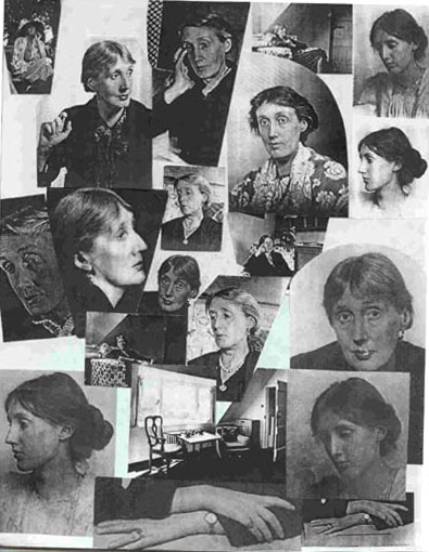

A STREAM OF LIFE
“I
want to give life and death, sanity and insanity;
I
want to criticize the social system, and show how it works, at its most
intense”.

As
the 20th century brings its first changes, i.e. the 1st
World War and its consequences, literature starts to adapt to the new tendencies
and to the new feelings in order to communicate in a deeper way; it is a period
of strong upsetting and the previous Victorian values, which had appealed so
much, simply seem to die off: they do not suit anymore the society of the time.
The
modern novel underlines the relationship between the internal and the external
worlds of the character, since writers feel it is time to really communicate
people’s feelings without the intermediation of a narrator. Finally characters
live into a limited perspective, but at the same time it is a reassuring and
apparently complete reality.
To
this turning point corresponds the need for new stylistic techniques: in 1890 William
James, an American psychologist, created the expression “stream
of consciousness”; this had to describe the unbroken flow of
thoughts, a set of changing inner impulses which an individual has while
unconscious.
The
stream of consciousness was readily adopted in writing and the first authors to
make use of it were Virginia Woolf (“Mrs
Dalloway”) and James Joyce (“Ulysses”):
there is a peculiar difference between their ways of studying the flux of
thoughts, which is the fact that in Woolf’s works time is not regarded as a
continuous stream, but as a series of different moments collected by the free
association of ideas; secondarily her characters’ thoughts belong by some
means to Woolf’s personality, which is not of little importance, because it
allows us to speculate about her figure and psyche.

Far from relating in an exhaustive way
everything about the English writer, it could be an interesting purpose to
denote how Virginia Woolf contributed to the growth of the communicative level
in prose: in fact she was able to represent the flow of time in centuries
(“Orlando”), in many years (“To the lighthouse”) and in only twelve
hours (“Mrs Dalloway”), according to Bergson’s theory of time[1].
Her works are made distinctive by a polished figurative language, full of
metaphors and assonances, with the abundant use of semicolons and hyphens, thus
representing her point of view about the typical feminine way of thinking.
It is said that a good psychiatrist
could reconstruct Woolf’s background and life, insofar as he read Mrs
Dalloway: apart from the literary aspects, this novel gave her the
possibility to express some nuances of her mind and of her complex sensibility.
First of all we should speak of the
theme of the double: Virginia Woolf created the figure of Septimus Smith, who is
seen as Clarissa Dalloway’s doppelganger, a darker personality, compared to
her social outlook. These two characters seem to represent herself, or at least
a part of her persona.
From any biography, we learn about the
author’s fear of the war, of the destruction brought by the second world war
into the streets of London (this soon led her to suicide, since she could not
afford all that stress): Septimus is an ex-soldier, who began suffering from shell
shock[2]
after having come back from war; this kind of disorder can be provoked by a
stressful situation, as well as a traumatic experience; Virginia’s
half-brother George, much older, sexually abused her and she incredibly suffered
from her parents’ death during her whole life. Therefore the theme of insanity
was close to her existence and, while speaking of the man’s distorted reality,
she could be describing her own situation: Woolf saw in Septimus the possible
“vicarious dead”, in order not to “kill” Clarissa Dalloway, and after
she committed suicide this character began to be associated more and more with
her.
Eventually the author’s deep
attraction for women (not only in a physical way) is to be found in most parts
of the book (e.g. when Clarissa remembers her past particular relationship with
a friend of hers).
In conclusion, what are supposed to be
Virginia Woolf’s merits?
She contributed to the development of new genre in a personal and original way; she succeeded in writing about things she strongly owned in her internal consciousness (and which belonged to her character); indeed she was able to describe reality, her sole aim, through thoughts, feelings and without her personal intervention. And what is more, she probably made us understand the real value of time, of The Hours of our life, better than anyone else, since she taught it to us through her personal life.

[1]
The French philosopher Henri Louis Bergson stated that there is an essential
difference between the internal time and the external chronology: the first
strictly deals with feelings and it is linked to a personal conception of
the flux of time, depending on the person’s sensibility; this has nothing
in common with the mere set of chronological moments, which make up every
man’s life.
[2]
Post-traumatic stress disorder (PTSD), colloquially called
“shell-shock”, describes psychological outcomes of traumatic and
life-threatening experiences; it is a mental condition in which the
individual is very close to a break from reality, due to combat exposure or
early childhood abuse. This trouble can co-occur with depression and/or
psychoses.